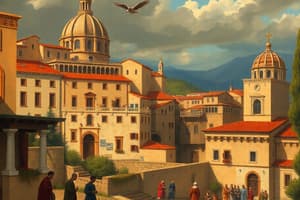Podcast
Questions and Answers
The intellectual movement that focused on human potential and achievements, known as ______, significantly influenced Renaissance art and literature.
The intellectual movement that focused on human potential and achievements, known as ______, significantly influenced Renaissance art and literature.
humanism
The invention of the ______ by Johann Gutenberg revolutionized the spread of knowledge during the Renaissance, making books more accessible and affordable.
The invention of the ______ by Johann Gutenberg revolutionized the spread of knowledge during the Renaissance, making books more accessible and affordable.
printing press
Martin Luther's challenge to the Catholic Church, initiated by his ______, led to the Protestant Reformation.
Martin Luther's challenge to the Catholic Church, initiated by his ______, led to the Protestant Reformation.
95 Theses
The ______ theory, which posits that the Earth and other planets revolve around the Sun, challenged the long-held geocentric view and sparked controversy during the Scientific Revolution.
The ______ theory, which posits that the Earth and other planets revolve around the Sun, challenged the long-held geocentric view and sparked controversy during the Scientific Revolution.
The ______, developed during the Renaissance, involves observation, experimentation, and analysis to draw conclusions, transforming the way knowledge was pursued.
The ______, developed during the Renaissance, involves observation, experimentation, and analysis to draw conclusions, transforming the way knowledge was pursued.
Flashcards
Renaissance
Renaissance
A cultural movement that began in Italy in the 1300s. It featured a renewed interest in classical Greece and Rome and emphasized human potential and achievement.
Humanism
Humanism
An intellectual movement that focused on human potential and achievements. It emphasized studying classical texts and promoted individualism.
The Vernacular
The Vernacular
Everyday language of people in a region or country.
The (Protestant) Reformation
The (Protestant) Reformation
Signup and view all the flashcards
Geocentric Theory
Geocentric Theory
Signup and view all the flashcards
Study Notes
- Artists and writers during the Renaissance expressed individualism through their focus on human potential and achievements, their embrace of classical learning, and their creation of realistic and emotionally expressive works.
- This expression of individualism led to a flourishing of creativity and innovation, and challenged traditional norms and values.
Birth of the Renaissance & the Italian Renaissance
- The Renaissance was a period of renewed interest in classical art and learning in Europe from the 1300s to the 1600s.
- Italian city-states thrived on trade, fostering a wealthy merchant class.
- The Medici family in Florence were patrons of the arts.
- Scholars and artists rediscovered and reinterpreted the classical civilizations of Greece and Rome.
- Humanism, an intellectual movement that focused on human potential and achievements, became prominent.
- Renaissance society became more secular, with a focus on worldly matters rather than solely on religious concerns.
- The "Renaissance Man" was an ideal individual who excelled in many fields, like arts and sciences.
- Renaissance art emphasized perspective, realism, and classical themes.
- Key Renaissance artists include Michelangelo (sculptor, painter), Donatello (sculptor), Leonardo Da Vinci (painter, inventor), Raphael (painter), and Gentileschi (painter).
- Writers began to use the vernacular, their native language, rather than Latin.
- Key Renaissance writers include Boccaccio (writer), Petrarch (poet), Machiavelli (political philosopher), and Vittoria Colonna (poet).
The Northern Renaissance
- Northern Humanists sought to reform society through education and promoting classical literature.
- Erasmus advocated for a Christianity of the heart, not just rules and ceremonies.
- Thomas More wrote "Utopia", about an ideal society.
- William Shakespeare is regarded as the greatest writer in the English language.
- Johann Gutenberg's printing press allowed for the mass production of books.
Luther Leads the Reformation
- The Catholic Church faced issues such as corruption and the sale of indulgences.
- Early reformers like Hus, Wycliffe, and Erasmus challenged the Church's authority.
- Martin Luther protested the sale of indulgences and other Church practices and emphasized salvation through faith alone.
- Indulgences were pardons that released individuals from sins.
- Luther posted his 95 Theses, formal statements criticizing the Church, on a church door in Wittenberg.
- The Protestant Reformation was a religious movement that split the Church.
- Charles V, the Holy Roman Emperor, opposed Luther's teachings.
- Lutheranism, a new religious denomination, emerged based on Luther's teachings.
- The Peace of Augsburg allowed each ruler to decide the religion of their state.
- Henry VIII established the Church of England/Anglican Church after the Pope refused to annul his marriage.
- The Act of Supremacy declared the English monarch the head of the Church of England.
The Scientific Revolution
- The Scientific Revolution was a new way of thinking about the natural world based on observation and experimentation.
- The geocentric theory (Earth-centered) was challenged by the heliocentric theory (sun-centered).
- Copernicus proposed the heliocentric theory.
- Brahe recorded astronomical data.
- Kepler proved that the planets revolve around the sun in elliptical orbits.
- Galileo Galilei's observations supported the heliocentric theory, leading to conflict with the Church.
- Isaac Newton developed the laws of universal gravitation.
Studying That Suits You
Use AI to generate personalized quizzes and flashcards to suit your learning preferences.




